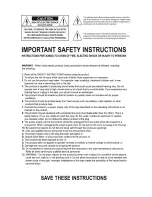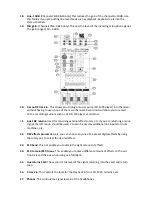
4.
Low cut 75Hz.
(Channels 1-6 only) This prevents any frequencies below 75Hz from entering
the microphone mix. This helps prevent low rumble feedback that can sometimes occur.
5. Gain.
This sets the level of the incoming microphone signal. The gain range is 10 – 60dB.
6. Peak.
This lights up when the signal into the channel is peaking. It’s ok if it lights up from
time to time during certain dynamics. If it stays on then the gain on the channel should be
reduced.
7. High.
This is used to cut or boost high or treble frequencies. When the potentiometer is at
12 0 clock, this is referred to as flat position meaning that high has neither been cut or
boosted
8. Mid
sweep.
This control works in conjunction with the mid frequency pot, adjusting or ‘fine
tuning’ the wide range of mid frequencies.
9. Mid.
This works in the same way as the high pot but adjusts frequencies in the mid range
10. Low.
This operates in the same way as the mid and high pot, boosting or cutting low (bass)
frequencies
11. Aux
(Auxiliary).
This pot controls the amount of signal that is coming into the Aux channel,
such as a monitor or fold back feed. Because it is routed before the channel fader (pre fade)
the monitor signal is not affected when the fader is adjusted. It is put into the mix via the
aux send input
.
12. EFX.
This controls the amount of built in vocal effect that is routed to the channel.
13. Pan.
This adjusts the position of the signal between the left and right outputs. Short for
panoramic after early American movie sound engineers who would move the microphone
in a panoramic fashion when capturing sound for the old movies, as the cameraman moved
in the same panoramic fashion! (useless information but true!)
14. Mute.
This isolates the channel from the mix. Ideal if specific microphone channels are not
being used for some time, for example.
15.
PFL.
Short for pre fade listen. When activated it enable you to listen to that one channel via
the headphones.
For optimum channel performance, the LED’s should be registering at
around 0dB. If they are pushing into the red section consistently, the gain on the channel
should be reduced
16. Fader.
This adjusts the mix of the individual channel and sends it to the main output. It
gives a precise fine control over the channel with easy to see level indicators. As a general
rule, try to keep the channel around 0dB or just below.
17. Line, L mono & R. (
Channels 7&8, 9&10 only). As with channels 1-6, these 2 channels have
a ¼” jack line input which also serves as the mono channel in these 2 stereo channels. The
primary function of these inputs is for signal source that require a stereo feed, such as
Keyboard, Music playback, drum machine, etc.


























